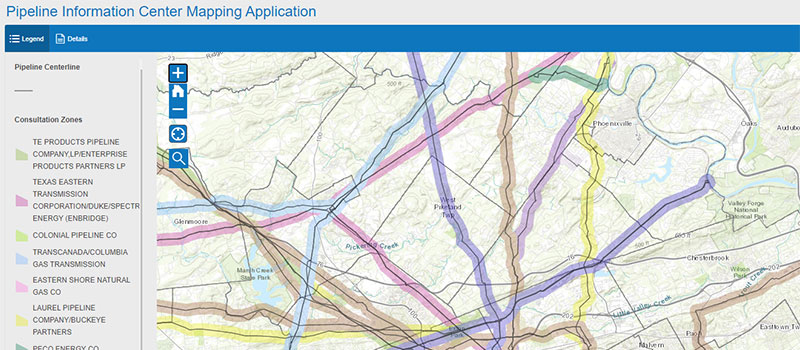Locating Pipelines
Pennsylvania 811 & the 811 Hotline

811 is the national number designated to protect landscapers/contractors from unintentionally hitting underground utility lines while working on digging projects. 811 helps access locator services in order to mark the approximate location of underground lines, pipes and cables, in order to dig safely. The purpose of Pennsylvania 811/Call Before You Dig is to prevent damage to underground facilities and infrastructure of all types, through providing efficient and effective communications network between project owners, designers, excavators, and facility owners. The site houses a resource center, FAQ section, and tabs specific to the user searching the site, including homeowners, project owners, excavators, emergency responders, facilitate owners, and others. Visit Website
 Finding Pipeline Operators and Existing Pipelines
Finding Pipeline Operators and Existing Pipelines
To determine the name of pipeline operators for existing pipelines, go to the Pipeline Information Centers interactive map. This map will allow you to zoom in on a specific area of interest. If you click on the area, a pop up box will appear giving you basic information on the pipeline operator. If you know the name of the pipeline operator, additional contact information can be found here.
Finding Pipeline Easements
To get detailed information about a specific parcel, you should contact the Chester County Recorder of Deeds and provide them with the parcel number of the property you wish to learn more about. The Recorder of Deeds can also help you locate a deed and determine if a pipeline company holds an easement on it.
 Response to Pipeline Incidents or Emergencies
Response to Pipeline Incidents or Emergencies
The DES Pipeline Response Information sheet provides a high-level overview of the response to a pipeline incident by local and county public safety officials. Exact actions taken during a pipeline incident will vary greatly based on the specific situation.
Pipeline Emergency Plan — 2023/2024
The Pipeline Incident Annex is a hazard specific document that addresses Chester County's preparedness, response, recovery, and mitigation efforts related to pipeline incidents. This plan is under development to address the Highly Volatile Liquid (HVL) pipelines and products in Chester County, while aligning with the Chester County Emergency Operations Plan (EOP), Chester County Hazard Mitigation Plan, Municipal-Level Pipeline Planning Annexes, and other policies and procedures. The Pipeline Incident Annex is an annex to the Chester County EOP, and will include plans related to schools, day cares, and long-term care facilities. The County met with the planning contractor, Innovative Emergency Management, Inc., in late December 2023 to continue revisions and updates. The county has received a revised document and are working through review. Municipal planning meetings have been held with Thornbury, Upper Uwchlan, Uwchlan, Wallace, West Whiteland and Westtown Townships and others are scheduled.
Once the majority of municipal plans are drafted, a series of tabletop exercises will be held, where the plan's content will be validated. Any additional revisions that are identified will be made at that time. Municipal plans are projected to be completed in February 2024, with exercises beginning shortly after, barring any unforeseen issues.
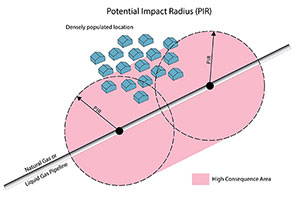
High Consequence Areas
The term High Consequences Area (or HCA) often appears in documents dealing with pipelines and pipeline safety. In broad terms, an HCA is a buffer that extends several hundred feet to either side of a segment of pipeline which passes through developed areas where people live in an urban or suburban setting, or where they frequently gather, like a school. Pipelines within an HCA are required to have extra safety features or extra precautions must be taken by pipeline operators depending on the type of pipeline, the material being conveyed, and other factors. Learn More
Regulatory Agencies and Information
U.S. Department of Transportation — Pipeline and Hazardous Materials Safety Administration (PHMSA)
 The mission of PHMSA is to protect people and the environment from the risks of hazardous materials transportation. To do this, they establish national policy, set and enforce standards, educate, and conduct research to prevent incidents. PHMSA encourages everyone to learn about pipelines and the products they carry, as well as learn a few simple steps to help ensure pipeline safety in your community.
The mission of PHMSA is to protect people and the environment from the risks of hazardous materials transportation. To do this, they establish national policy, set and enforce standards, educate, and conduct research to prevent incidents. PHMSA encourages everyone to learn about pipelines and the products they carry, as well as learn a few simple steps to help ensure pipeline safety in your community.
- Pipeline and Hazardous Materials Safety Administration
- Pennsylvania Pipeline and Hazardous Materials Safety Administration
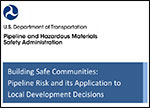 Building Safe Communities: Pipeline Risk and its Application to Local Development Decisions
Building Safe Communities: Pipeline Risk and its Application to Local Development Decisions
The purpose of this PHMSA report is to assist local governments and developers in better understanding pipeline risks and to provide a context for the use of recommended practices for development near hazardous liquid and gas transmission pipelines. The report was developed by the Pipeline and Hazardous Materials Safety Administration of the U.S. Department of Transportation.
Pipeline Safety Awareness Website — Official US Government Website for Pipeline Safety Awareness
More than 2.6 million miles of pipelines deliver energy throughout the country. The US DOT develops and enforces regulations, and partners with states who oversee most of the intrastate pipelines. This website, provided by the Office of Pipeline Safety under PHMSA, is dedicated to pipeline safety awareness. Through regulation and integrity management programming, PHMSA has reduced accidents and increased accountability for managing risk. According to the website, serious pipeline incidents have dropped by more than half over the past twenty years.
Natural Gas Pipeline Safety Act of 1968 and the Hazardous Liquid Pipeline Safety Act of 1979
Similarly, the Hazardous Liquid Pipeline Safety Act of 1979 as amended (HLPSA) authorizes the Department to regulate pipeline transportation of hazardous liquids (crude oil, petroleum products, anhydrous ammonia, and carbon dioxide). Both of these Acts have been recodified as 49 U.S.C. Chapter 601.
State Regulatory Agencies and Information
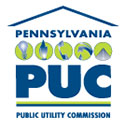 Each state that currently participates in the federal pipeline safety program has adopted pipeline safety laws for intrastate pipeline operators and facilities. In addition to identifying the department, commission, or agency that is responsible for administering the State's program, those laws establish the pipeline safety standards for owners and operators of intrastate pipeline facilities. At a minimum, these standards must meet the requirements codified in the Federal Pipeline Safety Laws (49 U.S.C. §§ 60101 et seq.) and Regulations (49 C.F.R. Parts 190-199). The Pennsylvania legislature has empowered the Public Utility Commission (PUC) to direct and enforce safety standards for pipeline facilities and to regulate safety practices of certificated utilities engaged in the transportation of natural gas and other gas by pipeline. The following PUC website links provide information relevant to pipeline safety:
Each state that currently participates in the federal pipeline safety program has adopted pipeline safety laws for intrastate pipeline operators and facilities. In addition to identifying the department, commission, or agency that is responsible for administering the State's program, those laws establish the pipeline safety standards for owners and operators of intrastate pipeline facilities. At a minimum, these standards must meet the requirements codified in the Federal Pipeline Safety Laws (49 U.S.C. §§ 60101 et seq.) and Regulations (49 C.F.R. Parts 190-199). The Pennsylvania legislature has empowered the Public Utility Commission (PUC) to direct and enforce safety standards for pipeline facilities and to regulate safety practices of certificated utilities engaged in the transportation of natural gas and other gas by pipeline. The following PUC website links provide information relevant to pipeline safety:
- Pennsylvania Public Utilities Commission
- The PUC and Pipeline Safety
- Act 127 (Pipeline Act)
- Gas Service Safety in the Pennsylvania Code
National Association of Pipeline Safety Representatives
The National Association of Pipeline Safety Representatives (NAPSR) is the national association representing State pipeline safety personnel in the contiguous United States as well as the District of Columbia and Puerto Rico. Through a partnership with the U.S. Department of Transportation, NAPSR members have oversight responsibilities for the safe and reliable transportation of natural gas and hazardous liquids through pipelines. The Pennsylvania contact person is:
Rob Horensky
Manager, Gas Safety Division
Pennsylvania Public Utility Commission (G)
PO Box 3265, Harrisburg, PA 17105-3265
Office: 717-787-1063
Non-Regulatory Pipeline Safety Resources
The Pipeline Safety Trust
 The Pipeline Safety Trust promotes pipeline safety through education and advocacy, increased access to information, and partnerships with residents, safety advocates, government, and industry, resulting in safer communities and a healthier environment. The Trust was created after a pipeline spilled 225,000 gallons of gasoline into a creek that exploded in Washington State, killing three. This and other tragedies have made communities look more closely at how pipeline safety, energy policies and practices affect residents and their environments
The Pipeline Safety Trust promotes pipeline safety through education and advocacy, increased access to information, and partnerships with residents, safety advocates, government, and industry, resulting in safer communities and a healthier environment. The Trust was created after a pipeline spilled 225,000 gallons of gasoline into a creek that exploded in Washington State, killing three. This and other tragedies have made communities look more closely at how pipeline safety, energy policies and practices affect residents and their environments
The Pipeline Safety Trust holds an annual conference in New Orleans, Louisiana. View conference agendas and presentations.
The Pipeline Safety Coalition
 The mission of the Pipeline Safety Coalition (PSC) is to "To gather and serve as a clearinghouse for factual, unbiased information; to increase public awareness and participation through education; to build partnerships with residents, safety advocates, government and industry; and to improve public, personal and environmental safety in pipeline issues." The PSC provides community mentoring and works to facilitate respectful and productive conversations between citizens, environmental groups, local/state and government officials and pipeline operators.
The mission of the Pipeline Safety Coalition (PSC) is to "To gather and serve as a clearinghouse for factual, unbiased information; to increase public awareness and participation through education; to build partnerships with residents, safety advocates, government and industry; and to improve public, personal and environmental safety in pipeline issues." The PSC provides community mentoring and works to facilitate respectful and productive conversations between citizens, environmental groups, local/state and government officials and pipeline operators.
Landowner's Guide To Pipelines
 This Guide, written by the Pipeline Safety Trust (PST) is intended to provide landowners with basic information about the pipeline system, how pipelines are operated and regulated, what rights and responsibilities you may have as a current or future landowner with a pipeline on your property, and where to find more information. While this this guide, describe the different types of pipelines, most of the discussion about property rights, easements, and eminent domain is pertinent to the large transmission and gathering pipelines, than to the small distribution lines that deliver gas to homes and businesses.
This Guide, written by the Pipeline Safety Trust (PST) is intended to provide landowners with basic information about the pipeline system, how pipelines are operated and regulated, what rights and responsibilities you may have as a current or future landowner with a pipeline on your property, and where to find more information. While this this guide, describe the different types of pipelines, most of the discussion about property rights, easements, and eminent domain is pertinent to the large transmission and gathering pipelines, than to the small distribution lines that deliver gas to homes and businesses.
Pipelines and Informed Planning Alliance (PIPA)
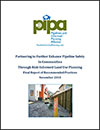 The goal of the Pipelines and Informed Planning Alliance (PIPA) is to reduce risks and improve the safety of affected communities and transmission pipelines through implementation of recommended practices related to risk-informed land use near transmission pipelines. The PIPA recommended practices describe actions that can be taken by key stakeholders relative to proposed changes in land use or new development adjacent to existing transmission pipelines. Local governments, property developers/owners, transmission pipeline operators, and state real estate commissions have key roles to enhance pipeline safety and ensure the protection of people, the environment and the pipeline infrastructure. View the PIPA Final Report: Enhancing Pipeline Safety Through Land Use Planning
The goal of the Pipelines and Informed Planning Alliance (PIPA) is to reduce risks and improve the safety of affected communities and transmission pipelines through implementation of recommended practices related to risk-informed land use near transmission pipelines. The PIPA recommended practices describe actions that can be taken by key stakeholders relative to proposed changes in land use or new development adjacent to existing transmission pipelines. Local governments, property developers/owners, transmission pipeline operators, and state real estate commissions have key roles to enhance pipeline safety and ensure the protection of people, the environment and the pipeline infrastructure. View the PIPA Final Report: Enhancing Pipeline Safety Through Land Use Planning
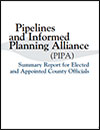 PIPA Summary Report for Elected and Appointed Officials
PIPA Summary Report for Elected and Appointed Officials
This information was published in support of an agreement which the National Association of Counties (NACo) signed with PHMSA in 2008 to help build county officials' awareness and capacity to improve transmission pipeline safety, through development and implementation of local land use practices. Information was taken directly from the PIPA Report with the purpose of conveying the report's findings and distilling the information specifically important to NACo members, including county elected and appointed officials, planners, emergency managers and other key county staff.
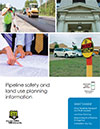 Pipeline Safety and Land Use Planning Information
Pipeline Safety and Land Use Planning Information
Paradigm Liaisons specializes in public awareness programming for the oil and gas pipeline industry. They have created fact sheets for local officials and emergency responders to use to help maintain safety around pipelines. These sheets include information on how to recognize the location of a pipeline, how to recognize a leak, information for First Responders receiving a call to report an emergency, and other ways to prevent damage to people, pipelines and property. View Fact Sheets
The School Pipeline Safety Partnership
 The School Pipeline Safety Partnership is a joint program sponsored by the Pipeline Association for Public Awareness and the Danielle Dawn Smalley Foundation. The Partnership's pipeline education program provides information and guidance to school administrators, safety offices and other staff, at schools located near pipelines. Safety information on their site includes information on leak recognition and response, finding pipelines near schools, protecting pipelines near schools, bus driver safety, activities for teachers (including links to the 811 Kids Program), and Safety Plan Checklists.
The School Pipeline Safety Partnership is a joint program sponsored by the Pipeline Association for Public Awareness and the Danielle Dawn Smalley Foundation. The Partnership's pipeline education program provides information and guidance to school administrators, safety offices and other staff, at schools located near pipelines. Safety information on their site includes information on leak recognition and response, finding pipelines near schools, protecting pipelines near schools, bus driver safety, activities for teachers (including links to the 811 Kids Program), and Safety Plan Checklists.
The following are links to a presentation on school safety from the Pipeline Safety Trust's 2017 annual conference given by Jeff Farrells from the Pipeline Association for Public Awareness.
Common Ground Alliance
 The Common Ground Alliance (CGA), formed in 2000 as a result of a US DOT study, promote best practices that result in the reduction and prevention of underground facilities throughout North America. The CGA offers resources and guidance to protect our utilities and those who dig near them, including a section titled "Damage Prevention in Your State," which displays damage prevention information, local contacts and rules for safe digging. View Pennsylvania
The Common Ground Alliance (CGA), formed in 2000 as a result of a US DOT study, promote best practices that result in the reduction and prevention of underground facilities throughout North America. The CGA offers resources and guidance to protect our utilities and those who dig near them, including a section titled "Damage Prevention in Your State," which displays damage prevention information, local contacts and rules for safe digging. View Pennsylvania
Additionally, CGA operates a Damage Information Reporting Tool (DIRT), which allows the submission of underground damage and near-miss reports through a completely secure, private web application. They also host a stakeholder advocacy toolkit that assists stakeholders in discovering best practices that have already been identified through the CGA, case studies & legislative activities, and contact information for stakeholder groups that they feel would be beneficial to engage in the process of building a legislative coalition.
Pipeline 101
Pipeline 101 is website that explores different aspects of pipelines — why do we need them, how do they work, where are they located, are they safe, how you can help with safety and the history of pipelines (which spans from the 1800s through modern day). This site takes a look at these topics, as it relates to the 180,000 mile liquid petroleum pipeline network and the 2.4 million mile natural gas pipeline network. Please note that the information presented in Pipeline 101 has been compiled from industry, government and research experts and published materials including 811, the American Petroleum Institute, and the Association of Oil Pipelines.
Liquid Energy Pipeline Association
 The Liquid Energy Pipeline Association hosts a safety page with information on safety records, safety actions, videos and more. It has links to information related to climate change, safety technology, safety records and keeping lines safe .
The Liquid Energy Pipeline Association hosts a safety page with information on safety records, safety actions, videos and more. It has links to information related to climate change, safety technology, safety records and keeping lines safe .
Texas Pipeline Awareness Alliance
 The Texas Pipeline Awareness Alliance is a group of Texas operators that want to increase public awareness about pipelines and pipeline safety. Their website offers information that can help you to find pipelines, learn about pipelines and their role in daily life, how operators keep lines safe, what to do if you suspect a problem, tips for farmers, and teaching your family about pipeline safety.
The Texas Pipeline Awareness Alliance is a group of Texas operators that want to increase public awareness about pipelines and pipeline safety. Their website offers information that can help you to find pipelines, learn about pipelines and their role in daily life, how operators keep lines safe, what to do if you suspect a problem, tips for farmers, and teaching your family about pipeline safety.
 First Responder Emergency Response Guidebook
First Responder Emergency Response Guidebook
The Pipeline and Hazardous Materials Safety Administration (PHMSA) developed this Emergency Response Guidebook, to provide first responders with a "go to" manual to help deal with hazmat accidents during the first 30 minutes. View the Guide


